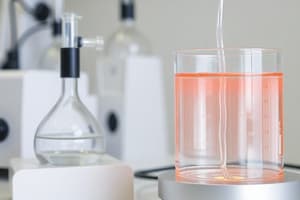Podcast
Questions and Answers
Which of the following is NOT a pure substance?
Which of the following is NOT a pure substance?
- Aluminum foil
- Cola (correct)
- Baking soda
- Distilled water
Which of the following is an example of a heterogeneous mixture?
Which of the following is an example of a heterogeneous mixture?
- Muddy water
- Homogenized milk
- Cola
- Chocolate chip cookie (correct)
What is the atomic weight?
What is the atomic weight?
- The number of electrons in the nucleus
- The number of protons in the nucleus
- The total positive charge of the atom
- The weighted average of all the neutrons and protons in the nucleus (correct)
Which industries require large amounts of cooling water for heat removal?
Which industries require large amounts of cooling water for heat removal?
What is the temperature difference between domestic and municipal sewage and the receiving stream water?
What is the temperature difference between domestic and municipal sewage and the receiving stream water?
According to the particle model of matter, what happens to the movement of particles as temperature decreases?
According to the particle model of matter, what happens to the movement of particles as temperature decreases?
Which of the following is true about subatomic particles?
Which of the following is true about subatomic particles?
What is the maximum amount of solute that can be dissolved in a fixed volume of solvent at a given temperature called?
What is the maximum amount of solute that can be dissolved in a fixed volume of solvent at a given temperature called?
Which of the following factors affect solubility?
Which of the following factors affect solubility?
What happens to the solubility of most solutes as temperature increases?
What happens to the solubility of most solutes as temperature increases?
Match the following types of mixtures with their descriptions:
Match the following types of mixtures with their descriptions:
Match the following terms with their definitions in the context of atomic structure:
Match the following terms with their definitions in the context of atomic structure:
Match the following types of mixtures with their examples:
Match the following types of mixtures with their examples:
Match the following factors with their effects on the rate of dissolving:
Match the following factors with their effects on the rate of dissolving:
Match the following substances with their behavior according to the particle model:
Match the following substances with their behavior according to the particle model:
Match the following industries with their heat release into the receiving water:
Match the following industries with their heat release into the receiving water:
Match the following terms with their correct definitions:
Match the following terms with their correct definitions:
Match the following types of solutions with their correct descriptions:
Match the following types of solutions with their correct descriptions:
Match the following factors with their correct effect on solubility:
Match the following factors with their correct effect on solubility:
Match the following terms with their correct definitions:
Match the following terms with their correct definitions:
Flashcards are hidden until you start studying




